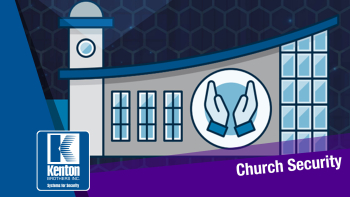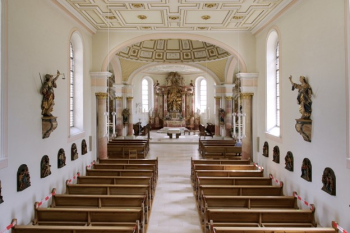Place of Worship Security: The Basics
By Mike Krohn, Project Manager at Kenton Brothers
 Where do you feel safe? Home? Work? In your car?
Where do you feel safe? Home? Work? In your car?
What about church? Do you feel safe in your place of worship? You should, right? After all, the church goes out of its way to create an inviting, warm, open-arms atmosphere to attract as many people as possible to worship and hear the Word. Whether you live in the big city, or a smaller community (as I do); attend a mega church with its own coffee shop or attend a burgeoning church in a rented building or school, we all want to relax and feel our place of worship is safe and secure.
Let’s face it, we live in an ever changing, constantly evolving world, which moves faster every single day. What were once hard-line standards and accepted practices are now being reimagined to accommodate current ideas and interpretations. Nothing is exempt from this, not even religion or the church. Sometimes, change and evolution are a good thing. But often, growth and change are painful and difficult to accept. This can lead to feelings of rejection, animosity, and unfortunately, even sometimes violence.
This year, my church will hold a global general conference and will be discussing some very controversial, if not popular topics. The way we worship may have to change. Many denominations are experiencing these same challenges. Many of us will adopt new opinions and attitudes and accept these changes. However, many people may view this as a slight to deeply engrained feelings about how they were raised in the church.
As a former law enforcement officer, security professional and facility director, I have worn many of the hats assigned to these issues. The energy behind our faith is strong and so are the feelings about how it should change. I’m fond of saying that where there is passion, there is energy; good or bad. In the case of a church where dozens or thousands of people will be gathered at any one time, this causes us to think more seriously about security at our houses of worship.
A Team Effort
The decision to increase security infrastructure and/or to have a security team or safety team is a complex effort, not to be entered into lightly or without the prerequisite foundational concepts being discussed. Again, this may change some well-established customs at your place of worship.
Physical infrastructure improvements rarely raise too many eyebrows, and the use of cameras, alarms, access control and projectile film have all become affordable, and often come with insurance benefits and discounts. As I said previously, while going from no security to physical site improvements and a safety team can be complex, we can and should make every effort to keep the team creation and operation as simple as possible.
Questions that need answers.
 Is the congregation and board willing to make these changes?
Is the congregation and board willing to make these changes?
Do they agree there is a need?
Are there people in the building willing to take on the responsibility?
-OR-
Are we going to hire out law enforcement/security professionals to keep us safe?
Do we have the infrastructure and equipment needed to create and equip this team?
What will this look like to the community? To the congregation?
Let us dive in and assume the idea of a safety team has been raised at your place of worship.
Q1. What comes first?
A1. A security assessment! This can be done by local law enforcementpublic safety staff, by an insurance company, or by a private security integration company (I am partial to Kenton Brothers Systems for Security!)
The assessment will go over items such as are exits clearly marked, how many points of entry to the church are there? Are there areas where people can be secured in the event of an incident/weather calamity etc? Where is the church located in the community? What is the crime rate in the local area? Where will people park and walk towards the building? How many people will be in the building at one time? Are there stairs, elevators etc.?
Q2. What equipment, if any, do we need?
A2. Communication tools! Two-way radios are almost a necessity. Flashlights, vests or identification badges are a solid idea to make these people readily identifiable when the need arises.
Q3. What operational changes are needed at our facility or building?
A3. Without being on your particular site, this is a more difficult question to answer, but common concerns range from creating traffic flow and parking lot designations with guided attendants, to limiting entry through certain doors at certain times. A general rule is one designated point of entry with attendants after services begin, or just prior. The remainder of all doors should be secured.
Q4. How do we prepare for an actual incident?
A4. Define the roles each member will have. DONT ASSUME ANYTHING! Practice! The teams should all know each other’s roles, and practice actual incident response from various approaches. Again, work to make these simple and realistic. Plans should be inclusive of every age group, from children to the elderly, and all levels of mobility from ambulatory to those who need assistance or wheelchairs.
Involving your local emergency responders is always a great idea. Invite them to tour the facility, see your video systems, doors and safety plans. Invite them to do an assessment, (sometimes they simply cannot for liability reasons) or just seek their input on your first or next training day. As a former SWAT commander, I can tell you, we were ALWAYS looking for places to train! WIN-WIN!
Finally, please remember this is NOT a comprehensive list or manual. These are just some thoughts to get the conversations going. Please seek out the professionals in your area, do the research, and work through this with the idea that the process will have a natural evolution as the church and community changes with the world around it.
If you’re interested in reference materials, they are out there!
There are so many great articles and books. I recommend:
“Evil invades Sanctuary – The Case for Security in Faith-Based Organizations” by Carl Chinn
“Defending the Flock – A security guide for church safety directors” by Kris Maloney
CISA.gov has a suite of resources for faith based organizations also. “The Physical Security Performance Goals for Faith-Based Communities”. The first in a series of impending related documents geared toward industry partners—are a set of physical security practices that houses of worship and related facilities can use to reduce security risks to their congregations. You can find them here.
Please stay safe, be well and and if we can help, please call us at Kenton Brothers Systems for Security!




Leave a Reply
Want to join the discussion?Feel free to contribute!